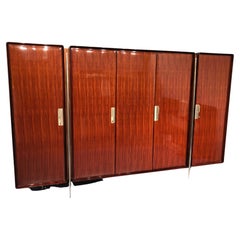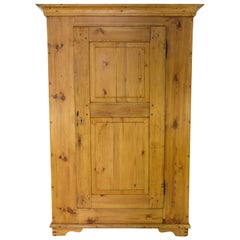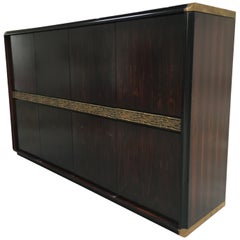Metal Wardrobes and Armoires
Color: Brown
Material: Metal
Mid-Century Modern Italian Teak Wardrobe designed Silvio Cavatorta, 1950s
Located in Traversetolo, IT
Stylish Italian mid-century modern teak wardrobe designed by Silvio Cavatorta in the 1950s.
The cabinet is made of gloss lacquered teak veneer with five doors finished with brass det...
Category
1950s Italian Mid-Century Modern Vintage Metal Wardrobes and Armoires
Materials
Brass, Steel
Hand Carved Wood Renaissance Period Armoire a Deux Corps or Buffet 1600s France
Located in Oklahoma City, OK
Important intricately carved tall hand carved French walnut armoire a Deux corps four-door cabinet from France 17th century from the Renaissance p...
Category
17th Century French Renaissance Antique Metal Wardrobes and Armoires
Materials
Metal, Iron
18th Century Louis XV French Provincial Carved Armoire or Wardrobe France 1700s
Located in Oklahoma City, OK
Standing at nearly nine feet high, this rare solid wood armoire or Buffet de château originating from the 18th century is an excellent example of French furniture during the 1700s. With a wonderfully rich patina, this large beautiful piece features intricate carvings throughout. The most unique feature is the bonnet with a bas relief which shows a carved Vanitas scene of a child resting upon a skull and book above a pair of intricately carved double doors. It can be used as a wardrobe or large moveable cupboard with doors and shelves for storing clothing or even perhaps a media cabinet.
Rare, Louis XV period armoires such as this are the epitome of French Provincial furniture. They are increasingly difficult to find in this condition, especially with their original hardware, for it was often removed and melted down for ammunition during the unrest of the late 18th and early 19th centuries.
This armoire or cabinet is monumental in size and weight. The main case of the piece is rectangular in shape. The bonnet cornice top or domed crown sits snuggly on top of two large scalloped paneled hinged doors. The double doors are elaborately carved with center medallions and open to reveal the inside which includes adjustable shelves and drawer for storage.
This wardrobe sits upon 2 cabriole legs in the front and two block legs in the back. Looking underneath the piece, at the bottom, you can see that the wood has been laid out and crafted in a way that resembles a cross. (See photos) Definitely a religious piece. It also features bow tie joints. Original grain can be seen and mortise and tenon joints.
This wardrobe exhibits historically accurate carvings with lovely symbolic details throughout and vividly demonstrates the excitement of the period. The center cartouche at the top of the bonnet is embellished by a vanitas theme carved child resting in repose on a bed with a book, and a skull without a jaw underneath.
This is commonly known as Vanitas or Memento Mori in Latin, meaning "Remember You Will Die". This sentiment is the Medieval Latin Christian theory and practice of reflection on mortality, especially as a means of considering the vanity of earthly life and the transient nature of all earthly goods and pursuits. It also resembles Eros. Traditionally, the skull represents death, evil, fear, and mortality, but it can also symbolize the complete opposite: protection, power, and gratitude toward life. Which points to the French custom of a father's gift to his newborn daughter. The crafting or purchase of an armoire carved with symbols of plenty and happiness stayed with her throughout her life and was used to store her trousseau in her own home once she married.
Regardless of its symbolism, the skull stands as a constant reminder that no one can escape death. For example, the appearance of skulls on some Christian rosaries is said to reflect the Latin expression Memento Mori, meaning ‘remember that you shall die.’
Below this beautiful figural carving are two large domed doors also with intricate carvings The carvings are very well-articulated and in wonderful condition for the age.
A serpentine apron features a beautifully carved rocaille (Rococo shell) cartouche and foliate.
Original hand forged mountings and double-bolt locking mechanisms characterize this brilliant 18th-century furnishing and tell the story of the time period. The two massive doors feature a beautiful, intricate steel locking mechanism stamped with the Fleur de Lys which signifies that the piece was crafted either for the nobility or royalty.
The first armoires appeared in France during the latter half of the 17th century and were most often the dominant feature of the home. These large cupboards were used to hold a family’s belongings from linens to clothing to silver and even food. Originating in France, the French provincial style was born of the ornate Louis XV and Rococo. However, it was crafted by furniture makers in the provinces, outside of the cities. By nature, its beauty relies more on form, function and available materials, and less on ostentatious decorative elements, such as gilding or intricate marquetry.
Pieces of this time period were carved with great artistry and skill, yet were made to be functional and long-lasting.
One of the most significant features of fine Provincial armoires are the locks and hinges. Because these cupboards were a very important part of the household, little expense was spared in outfitting them with the finest hardware. Long ornate hinges and elaborately scrolled escutcheons were an integral part of the overall design of the armoire. Often, the hinges, lock, and key cost more to produce than the armoire itself.
The expense of such a grand armoire was enormous and it often served as an indication of a family's wealth and social standing. As their wealth and possessions grew, armoires were added to the household and it was not unusual for a wealthy family to have several armoires.
This beautiful piece could be used as an armoire, wardrobe, linen chest, cabinet or storage cupboard. Or perhaps as a TV entertainment center...
Category
18th Century French French Provincial Antique Metal Wardrobes and Armoires
Materials
Iron
Antique Baltic Pine One-Door Armoire
Located in Barntrup, DE
One-door armoire of Baltic pine with five shelves. The wardrobe is in one piece and is of very solid construction and in very good antique condition. Please expect some dents, marks ...
Category
1920s Latvian Baltic Vintage Metal Wardrobes and Armoires
Materials
Metal
Antique One Door Baltic Pine Armoire
Located in Barntrup, DE
This unique and antique one door Baltic pine armoire or wardrobe was handcrafted in late 19th century. On the armoire is dated 1868, but it could be made earlier. There are two shelv...
Category
1860s Latvian Country Antique Metal Wardrobes and Armoires
Materials
Metal
Mid-Century Modern Italian Ebony and Bronze Wardrobe by Luciano Frigerio, 1970s
Located in Prato, IT
Mid-Century Modern Italian ebony and bronze four shatter wardrobe by Luciano Frigerio for 'Frigerio di Desio' from 1970s.
This armoire is equipped with a chest of drawers and a shel...
Category
1970s Italian Mid-Century Modern Vintage Metal Wardrobes and Armoires
Materials
Bronze
Recently Viewed
View AllMore Ways To Browse
2 Door Wardrobe
Mirrored Vintage Wardrobe
Antique Cupboard Wardrobe
Hand Painted Wardrobe
Single Door Wardrobe
Small Hanging Cabinets
Armoire Style Vintage
Raised Panel Armoire
Closet Storage
Armoire Vintage 1960
Wardrobe 18th Walnut
Antique Armoire Pair
Armoire 2 Door
Antique Wardrobe Small
Small Wardrobe Antique
Used Closet Cabinets
Small Antique Wardrobes
Wardrobe Hooks





